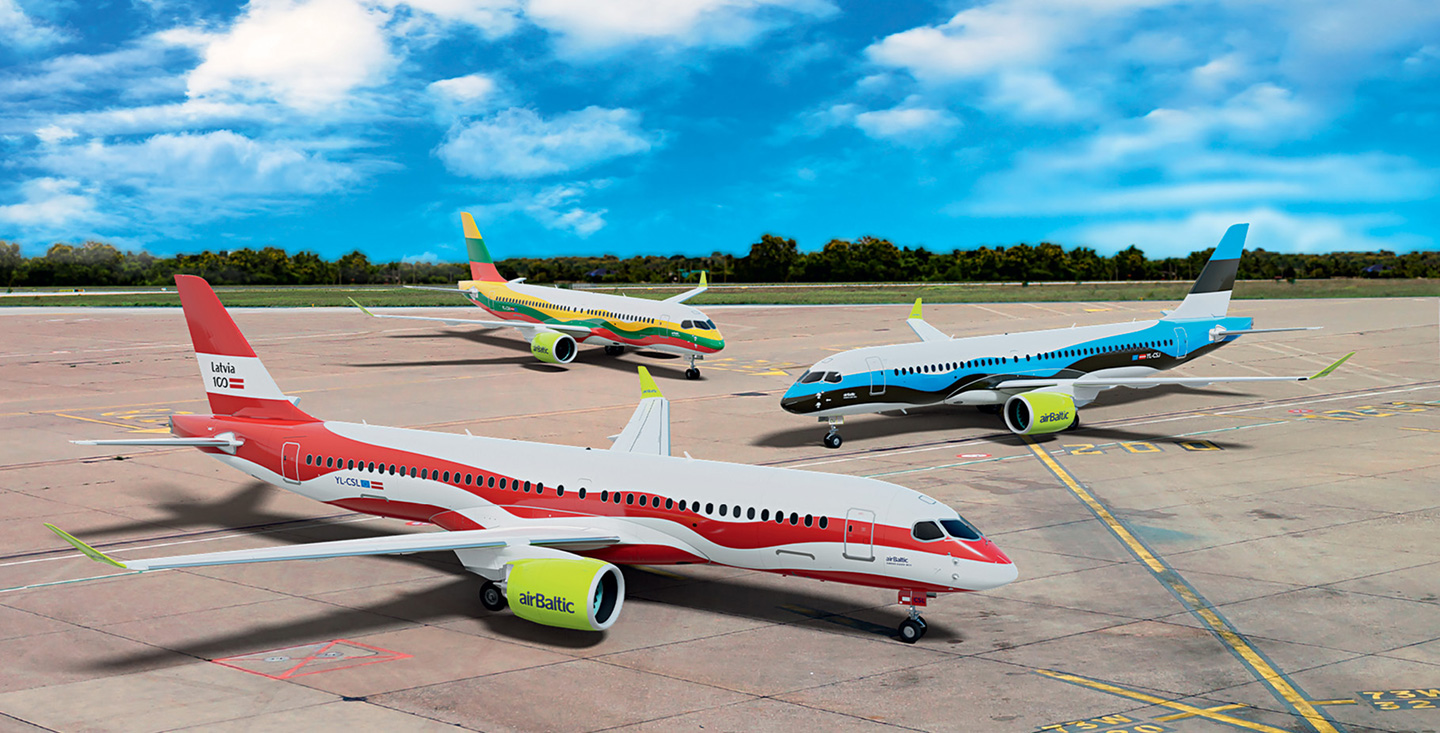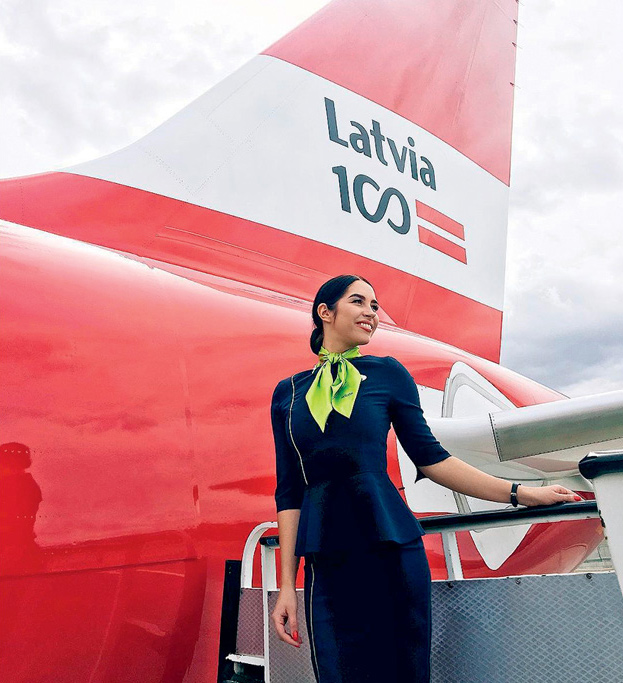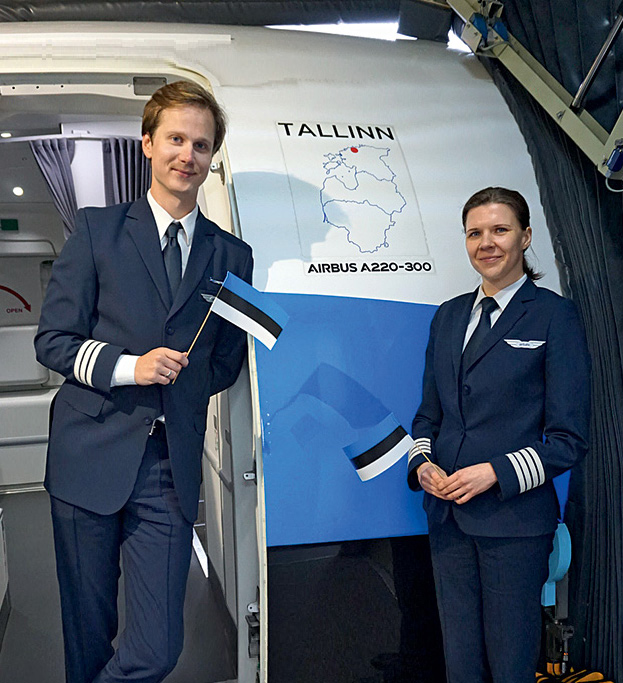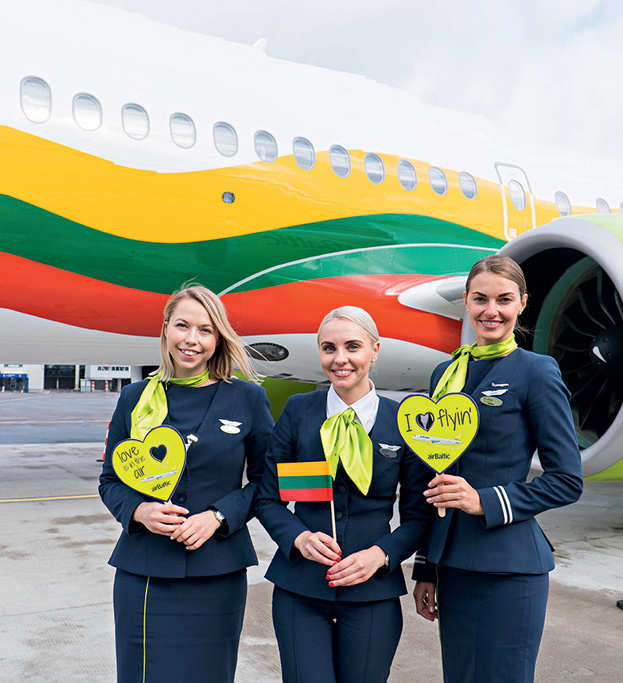Words by Līga Vaļko
Photos courtesy of airBaltic
High in the sky
airBaltic’s special livery
airBaltic has one of the most modern fleets flying across Europe. Three of its aircraft have been repainted in special liveries to reflect the unique DNA of airBaltic and the Baltics.

As the leading carrier in the Baltics, airBaltic is serving more and more direct routes not only from its central hub of Riga International Airport but also from Tallinn and Vilnius. To build up a shared sense of national belonging in the Baltics, airBaltic introduced a series of special liveries on its fleet, representing Latvia, Estonia, and Lithuania.

First flight:
November 10, 2018, to Munich
Number of flights
till October, 2020:
2249
Number of destinations:
64
Kilometres flown
till October, 2020:
3,243,341
Registration number:
YL-CSL
The first special-livery aircraft made its debut in 2018, when airBaltic unveiled an exclusive Airbus A220 aircraft featuring the national symbol of Latvia – a carmine-red flag with a white band in the middle. This was a gift from the airline to Latvia on the country’s centenary. The tail of the aircraft displays the official LV100 graphic identity of the centenary campaign. Alongside the stunning design, the aircraft itself bears the name of Latvia’s capital city, Riga.
This was the first time in the history of airBaltic that the airline presented a full special livery. ‘We at airBaltic live up to our core values and act as ambassadors of the Baltics. With the special liveries, we have unlocked a world of opportunities to spread the word about all three Baltic countries,’ explains Jānis Krištops, a captain on A220-300 aircraft and safety manager at airBaltic.
A giant salute to the Baltic countries followed as the 30th anniversary of the Baltic Way approached. The record-long human chain had weaved through all three countries in August 1989 in a peaceful demonstration for national independence. airBaltic wished to rekindle the pride of the people of the Baltics, and, during a special event in August 2019, it presented liveries repainted in the colours of the Estonian and Lithuanian flags as well. ‘It was like a fleet parade in which all three Airbus A220-300 aircraft with national-themed liveries moved in a synchronised fashion on the grounds of Riga International Airport,’ Krištops remembers.

First flight:
June 29, 2019, to London
Number of flights
till October, 2020:
1374
Number of destinations:
57
Kilometres flown
till October, 2020:
1,796,022
Registration number:
YL-CSJ
The painting process
The flags of all three Baltic countries now proudly wave on airBaltic’s aircraft high in the sky. But the project began quite some time earlier, when the special liveries were created by 15 painters using 250 litres of primer, paint, and clearcoat. It took a total of 1000 hours to complete.
‘The repainting of the special livery is no different than regular aircraft repainting,’ says Staņislavs Kirillovs, an Airbus A220-300 type engineer. ‘First, it’s necessary to ground and defuel the aircraft, remove various external equipment, and mask all the areas that will not be painted. For airBaltic’s special livery, only the aircraft’s body and tail section were repainted, so all the other major surfaces, such as wings and engines, were masked.’
The most challenging aspect of repainting is careful surface preparation, which affects how the aircraft surface and paint bond together. It takes time and patience to remove the previous layer of paint because it is crucial to not damage the composite structure or leave paint layers any thicker than they need to be.
The painting process of airBaltic’s special liveries was broken down into several steps. First, a layer of primer was applied, and then, within 24 hours, a white base coat was added to all surfaces. Once the base coat had dried, the aircraft livery details were applied one by one: carmine red for the livery of Latvia; blue and black for Estonia; and green, yellow, and red for Lithuania. Emergency and technical markings were also applied, and then the aircraft was sprayed with a clear-coat finish to add gloss and ensure that the colour is retained. The last step in the process was physical weighing to identify whether the aircraft’s weight and centre of gravity had not changed.

First flight:
August 8, 2019, to Moscow
Number of flights
till October, 2020:
1171
Number of destinations:
57
Kilometres flown
till October, 2020:
1,540,942
Registration number:
YL-CSK
Secret mission
Once the repainting of the special livery was complete, Krištops was tasked with finding a companion and embarking on a secret mission to bring the repainted aircraft from Tallinn, where the painting had taken place, back to Riga. He was the first to fly the aircraft with the special livery of the Latvian flag. ‘That special flight was scheduled during the night to make sure that no one found out about the special livery before it was announced to the public on November 9, 2018,’ he remembers.
To commemorate Latvia’s centenary, the newly painted aircraft participated in the centenary parade, flying in formation with fighter aircraft above the Daugava River on November 18, 2018. airBaltic chose a distinct call sign, BT100, for this memorable flight. ‘This is an occasion that I’m very proud to tell my kids about. I had such a once-in-a-lifetime opportunity to participate in the parade, flying the aircraft as Latvia celebrated one hundred years since it became an independent state. Perhaps something similar will happen only a hundred years from now,’ Krištops says as he remembers being completely mesmerised by the experience. But this wasn’t the only time Krištops flew the aircraft for a special event. He also took part in last year’s parade and this summer’s aviation festival at Spilve Airport, which marked the 100th anniversary of Latvian aviation.
The aircraft instantly draws attention. ‘My first regular flight with the special Latvian livery was to Vienna,’ Krištops continues. ‘Still today, people are positive and very eager to take photos with the aircraft. In fact, many enthusiasts specifically seek out special liveries. I remember one time in Amsterdam, when an airport ground vehicle swiftly stopped to get a shot of our special livery. Instead of using just a smartphone, the employee had a professional camera and huge lens. This aircraft with special livery has definitely achieved its goal by creating a strong sense of unity and togetherness. It makes me feel that I’m part of a bigger family, part of Latvia, and part of the Baltics,’ he concludes.